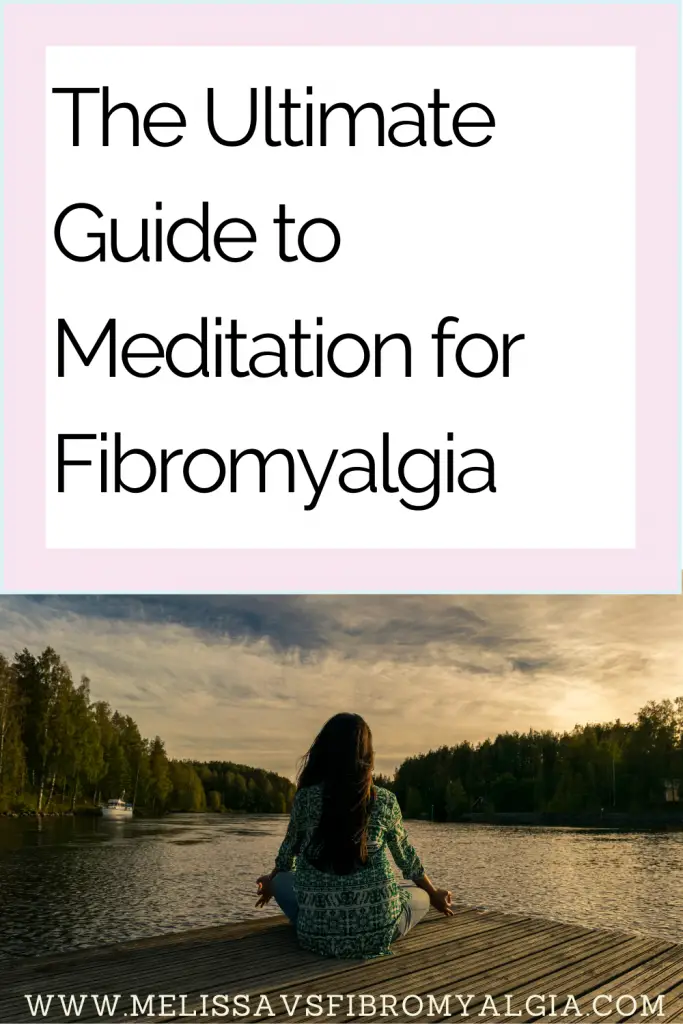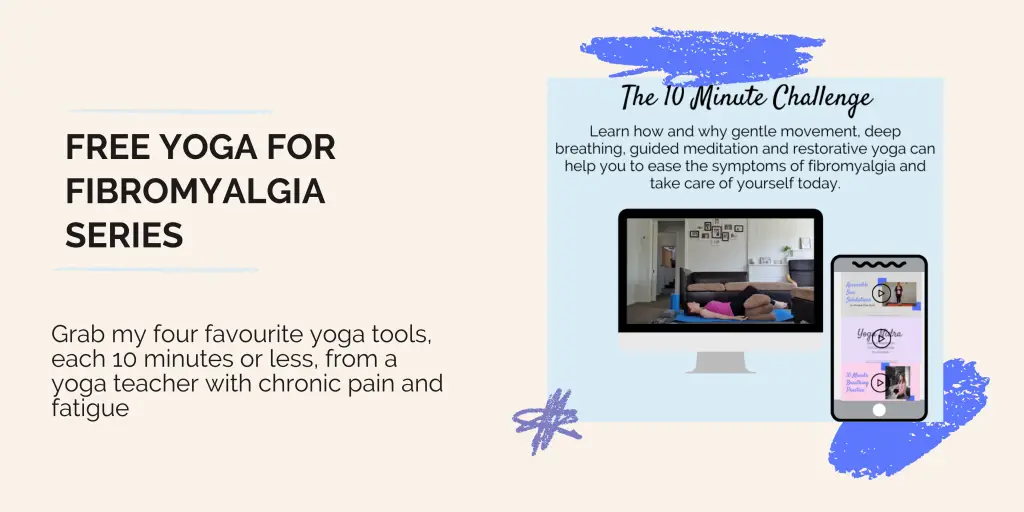Last Updated on March 17, 2024 by melissanreynolds
Meditation is a fabulous tool for fibromyalgia/chronic pain/chronic fatigue. Anything that promotes deep rest is a helpful addition to our toolkit. Anyone following this blog for any amount of time will know how much I love Yoga Nidra guided meditation.
Loads of us have heard the spiel, the idea that it will be some kind of magical panacea. I get it. Many of us have tried it to little benefit. Especially when we have been told to try it seated either on a cushion or hard floor. Oh heck no! I don’t have the time or energy for that nonsense.
I want my meditation to double as profound rest. And I want the secondary benefits.
So let’s talk about the benefits of meditation, the types and how you can build your own meditation practice.

Listen, Watch or Read
About six years ago I began practicing and as I experienced the benefits I started researching and learning more. As is obvious by a blog full of more than 300 posts, I am a questioner who researches!
I began to link the benefits of meditation to a deeper root cause of fibromyalgia. In the Fibromyalgia Framework Series I linked meditation as a key tool for managing the central nervous system overdrive that exists in fibromyalgia.
Here is the gist of it:
Fibromyalgia appears to be the result of an overactive nervous system. Specifically a hypothalamic dysfunction. Google, “hypothalamic dysfunction fibromyalgia” and you get 12,500 results. Google “neuroinflammation fibromyalgia” and you get 212,000 results. Search “central nervous system fibromyalgia” and you get over two million results. There is something here! My brain fogged brain hasn’t got there yet, I just know this is the right direction.
Key point: It is part of the brain structure, not in your head. It is not psychosomatic, it cannot be fixed by counselling (although counselling may be a helpful part of healing because it is stressful and hard to live with constant pain, fatigue, insomnia etc.)
Meditation helps calm the central nervous system.
Some people believe that the presence of chronic pain results in changes to the brain.
Meditation can help reverse these changes.
“Through meditation, Dr. Pohl hopes to reverse some of the negative changes in the brain that can occur with chronic pain. “We have seen a decrease in cortisol and epinephrine levels, an increase in serotonin and gamma-aminobutyric acid levels, which are linked to relaxation and antidepression, and an increase in natural killer cells. With sufficient practice, patients can establish patterns of thought that diminish catastrophization, thus decreasing pain,” he said.” Practical Pain Management, Meditation: A Pathway to Pain Relief
It’s not simple though
You can’t just “fix” the brain issue and be cured. Because the body is a whole – all of our systems are connected. Doctor Rutherford considers the brain to be the first domino. There are downward effects that affect other systems of the body. Hence the complexity of our symptoms.
Plus we don’t have a way to magically fix the brain. Low dose naltrexone can help with neuroinflammation. Calming the central nervous system can help. We have the tools to dramatically reduce our symptoms but not a cure.
This is a long video from Doctor Rutherford but worth watching if you want to understand the concept (it is more theory than practical applications i.e.. concrete steps to take).

So what concrete steps can we take?
Look into reducing neuroinflammation, managing the central nervous system and working on the big dominoes. This is where meditation comes in.
My Ultimate Guide to Managing Fibromyalgia post may help you here.
If the benefits, hows and whys don’t interest you as much as practical steps – Click here to download your own free Yoga Nidra meditation to try.
Benefits of Meditation for Fibromyalgia
- Complete rest
- Calming the central nervous system
- A break from stimulus
- Focus on the body, accepting it as it is (mindfulness).
- Not trying to nap, which can be frustrating for those who can’t.
- For those who have trouble with orthostatic intolerance, just lying down can make you feel better.
- A boost in energy (however temporary).
- Improve the immune system (University Health News Daily, 2018)
- Treat depression
- Reduced anxiety
- Reduce pain
How Can You Meditate?
- Simply focus on your breath for a few moments. How you breathe in, how the breath feels a little warmer on the way out. How your body feels when you exhale. How your breaths get a little longer as you relax. Don’t push anything, just observe.
- Do your own body scan meditation – by quietly thinking of each part of your body in turn, noticing the feeling in each, accepting it, willing that part to relax and moving to the next.
- Progressive relaxation – by tensing and releasing each part of your body in turn, you can encourage it to relax deeply. As an example, you could start with your feet, tense and release, your lower legs, upper legs, glutes, abdomen, arms, face.
- Guided meditations – there are body scan meditations, Yoga Nidra, mindfulness meditations, meditation specific to pain or fatigue etc.

How Do You Experience the Benefits of Meditation?
By doing it. Regularly. Make a commitment and practice.
I have meditated almost every day for several years. I cannot cope without it now – it provides deep rest after lunch to counteract the poor quality of sleep and the fatigue.
You need to find the type that resonates with you the most so that you will continue it.
I suggest Yoga Nidra guided meditation because you can do it lying down, in your bed with your heat pack. Perfect for people with chronic pain and fatigue!
You can do it
- First thing in the morning if you don’t feel you’ve slept well (most of the time with fibromyalgia?)
- During a flare
- In place of a rest/nap (especially useful if you cannot nap but really wish you could)
- After work
- Before bed
- During the night (it is great for those painsomnia nights)
- Basically whenever suits you
The thing about Yoga Nidra (or any meditation) is that it should feel good in the moment and give you some much needed rest. But it is also quietly working in the long term.
Consistent practice has reduced my central nervous system overdrive over several years. I get less anxious, less easily. It is easier to get to sleep and I achieve more periods of deep sleep.
Ways to Get Started Today
If Yoga Nidra for Fibromyalgia is of particular interest to you, then you might like to join this course which takes you through my absolute favourite tool in my daily weapons cache for fighting fibromyalgia. With practices from 10-30 minutes, including practices specifically for sleep, you will be well equipped to use this tool forever.
Another offering I have for you, which may help you in creating your meditation habit/practice is the free Yoga Self-Care Challenge. This is an eight day challenge that will take you through four yoga practices, including one Yoga Nidra and one breathing practice to help you experience these tools. All four practices will help calm the central nervous system. This is like your starter kit and you will be ready to consider what next in your practice.

Conclusion – Meditation for Fibromyalgia, worth it?
We have looked, in brief, at my current theory about the root cause of fibromyalgia. The benefits of work on our central nervous system through meditation. And several ways you can experience these benefits yourself. These tools, once learnt, are yours forever to use anywhere, anytime. These are my favourite kinds of tools! So, as someone who has already benefited from it, I’d say yep, it’s worth a try.
Tell us below: have you tried meditation? Has the practice helped you?


I can see it’s definately helpful to relax the body and calm the nervous system. With lyme I learnt that a big part of it was trauma, and doing Somatic Trauma work helped me to come down out of fight and flight more, especially times when I was stressed and would just shut down physically.
Some of it is similar to mindfulness but it’s focusing not just on your body on the chair/bed/whatever and your breath, but also the outside environment since we disconnect from the environment and from our own body with trauma. And eventually layer each part in.
Interestingly you seem to have come to similar conclusions in a different way, glad you’ve found something that helps. I think the challenge for alot of us, especially if we have alot of symptoms is doing it consistently. I was able to because I got to a place where I really just wanted to get better so would spend alot of time on this, Qigong and other practices.
Great post! Thank you for simplifying and summarizing some of the various approaches to meditation – it makes it really easy to understand. Even a brief meditation can be very beneficial – when the mind is calm, it’s easier for the body to follow along!